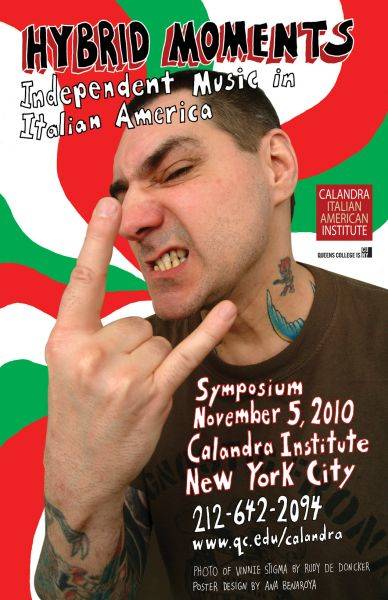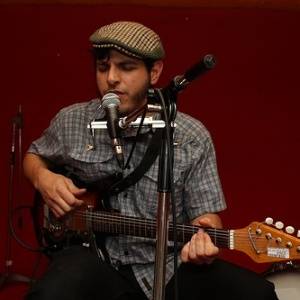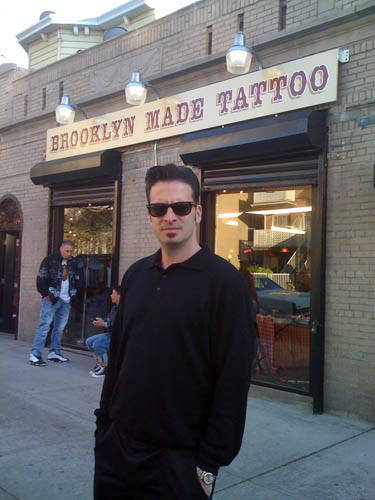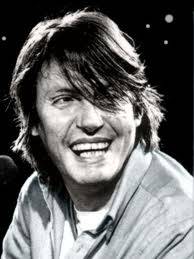Hybrid Moments: Italian American Identity and Indie Music
What comes to your mind when you think of Italian-Americans and music? Probably Frankie Valli and the Four Seasons, Frank Zappa and, of course, Frank Sinatra. Or maybe the techno music blasted on the South shores boardwalks and clubs. Both of these associations are obviously correct and rooted in the Italian-American culture.
But, what about the contemporary alternative music scene? Grungy bands in the Lower East Side, the punk and hardcore culture don’t immediately remind us of “Italianness”, but a closer look at the last name of some artists, the personal background, the titles and the themes in their lyrics or their stage persona reflect an Italian-American heritage.
A series of events at the Calandra Institute explores this subculture within another subculture. The music itself speaks to a larger crowd and doesn’t lead to a complete identification but it is fascinating to explore this subject.
The program “Hybrid Moment” spans from exhibits to movie screenings, to lectures and presentations and the Symposium begins on November 5, 2010. We sat down with Rosangela Briscese, one of the organizers of the event.
What inspired you to create this event ?
I thought about it for a while because of musicians that I know that are Italian-Americans and who are not typical Frank Sinatra-style singers, but I noticed that they embodied some ways of being Italian-Americans in their performance style, but people didn’t necessarily think of as a stereotypical Italian-American. So it seemed like they were involved with their Italian-American culture even though you might not think of them as typical.
An example of some performer that shows these traits?
There’s one of the musicians who’s coming to our event , Vic Ruggero, (The Slackers) and he has an onstage persona that is kind of old-school New York. He wears a hat and a white undershirt, he has a very heavy Bronx accent, a lot of his songs are about guilt, crime, and darkness and redemption and sin…
I’ve been to other parts of the country and I’ve seen The Slackers perform, in Michigan or Texas: people in the audience really respond to the fact that he’s a New Yorker Italian, so I thought that he was really interesting because he doesn’t correspond to a typical image.
I brought it up with my coworker Lucia Grillo and she said that she had been thinking about a lot of the same things and that she was also very interested in the hardcore, punk scene. We realized how many IAs (Italian Americans) are involved in these kind of more alternative genres and how, again, it is not stereotypical, not the clubs scene, “fist-pumping” but it is its own subculture. People go to their concerts and they have their own hairstyles, their own clothes, their own group within the hardcore culture.
Another example is Vinnie Stigma who is a major figure in the New York hardcore scene, specifically the Lower East Side: his band is very big, so we started to think about how, once again, they are seen as non stereotypical but at the same time they are Italian-Americans, they are just interpreting the culture their own way.
For some of the singers their identity is veiled, like Ani Di Franco, and for others, like the ones you mentioned, it is more overt. Towards which one of these attitudes do you think the youngest generation is moving?
It’s complicated because the youngest generation might be assimilated but they also refer to italianness as a way to get back in touch with their roots .
It’s hard to say because there are definitely a lot of young IAs involved in indie music that don’t really feel their Italianness and that’s something that came up when we started inviting people.
I don’t know, though, if it’s a generational thing or not, because we got in touch with a pretty wide age group, and we kept having opposite responses: we had those that even if they had never really thought about their identity were interested in this topic after we brought it up, but also those that felt like they were so distant that they couldn’t think they could contribute, they didn’t want to contribute. Fugazi’s lead man Guy Picciotto, who’s in a band that takes his title from an IA expression, for example, was part of the latter group: he didn’t feel connected.
Do you think the audience is somewhat aware of the heritage of these singers?
I think some of them are, but it depends. One example is Ted Leo, half Italian and half Irish. I’ve seen him perform and listened to him on the radio and he refers to his Irish heritage a lot more. I said to one of my friends that we were inviting him and she replied: “Ted Leo! But he’s Irish! Is he Italian?”
A lot of people aren’t aware or maybe they are simply used to assimilation and they see the ethnic identity but it kind of goes over their head.
Is one of the goals of this event to make the audience more aware?
Yeah, I think our goal is to make people aware of their heritage, but not just because we want to say “look there are so many Italians doing so many great things” ; our efforts are about showing that there is a diversity within the community, It just fits in the larger picture of the events that we do at the Calandra Institute of showing that there are IAs that are scientists, other are graffiti artists and all kinds of other things. Bring awareness as part of a larger picture of the Italian-American experience.
Do you see a difference in relation to how other ethnic groups embrace music, like how African American culture relates to music as part of their ethnic identity?
Well, yes, because we’re not saying punk is Italian even though there were a lot of Italian-Americans involved in some of the very early famous bands, like the Misfits – by the way that’s where we get the title of the Symposium from “Hybrid Moments” , in fact they are a band from northern New Jersey and most of their members were IAs. We’re not saying that there is a certain kind of music that is exclusively IA or correlated with being IA, we’re showing what it’s like to be IA and to be making music as part of an underground scene.
What about the event The return of the Son of Shut Up n’ Play Yer Guitar: Zappa plays Zappa and De Andrè plays De Andrè. Are Americans familiar with this Italian poet and legendary songwriter, Fabrizio De Andrè?
I think for most of the audience it will be the first time they are introduced to him and in this specific presentation Goffredo Plastino will have video and audio clips so it will give people a sense of what the music sounds like and he will try to contextualize him ad I think people will be able to understand him if they think of similar American musicians. They will be taking it in all at once and they will also learn who he is, who his son is, and what his relation is to Frank Zappa.
There’s also an exhibit and a movie.
We opened the exhibit last Wednesday and we had a great response. The photographer is IA, was born in Italy, and came in the USA when she was 8. Her father is Sicilian and her mother is from Bolzano, so she has a very interesting background. She talked about the experience of being an immigrant and feeling like an outsider and then photographing these punks and skinheads, these outsiders tied things together, making the connection between feeling like an outsider and observing outsiders. She likes to photograph groups on the fringe. And the movie is about three brothers in New Jersey who were in a punk band in the 1980s, they played local shows and their biggest gig was the CBGB and again we wanted to show the diversity of the IA experience. We are showing it the night before the Symposium (November 4) and our idea is to introduce people to the subject before the discussion begins, showing an example, visualizing things. It’s not a movie about someone famous, it’s about regular people, the “average community” as the title says. It focuses on what it was for them to grow up. It takes place around the same time the photographs were taken.
Also in terms of the musicians and singers involved, I’d like to specify that we’ve branched out to the bigger alternative, independent music scene, instead of focusing on certain specific genres like punk and hardcore. We want people to embrace what it means to be Italian-American and to be involved in this underground scene.
*********
Symposium Program (subject to change)
9:30-10:00 am
Coffee & Pastries
10:00-10:30 am
Introductory Comments
Rosangela Briscese & Joseph Sciorra (John D. Calandra Italian American Institute)
10:30-11:30 am
East Coast Metal
During the 1980s, Italian-American musicians in bands like Anthrax, Dry Kill Logic, and Stormtroopers of Death created an alternative to California's metal scene in the Bronx and Westchester, New York.
Moderator: Joseph Sciorra
Participants: Howie Abrams (A&R Consultant/Artist Manager), Rob Caggiano (Anthrax) & Nicholas Sciorra (Sciorra Media Group)
11:45 am-12:30 pm
The Return of the Son of Shut Up 'n Play Yer Guitar: Zappa plays Zappa and De Andrè plays De Andrè
Goffredo Plastino (Newcastle University/Association for Cultural Equity)
12:30-1:45 pm
Lunch on your own
1:45-2:45 pm
Anima e Hardcore
Two influential proponents of punk talk about the rough sounds and mean streets of New York's hardcore scene.
Moderator: Gerry LaFemina (Frostburg State University)
Participants: Carl Porcaro (Killing Time) & Vinnie Stigma (Agnostic Front)
3:00-4:00 pm
Italianità in a Minor Key
Ruminations on the sometimes veiled, sometimes overt Italian-American presence in the indie scene.
Moderator: Antonino D'Ambrosio (La Lutta NMC)
Participants: Kaves (The Lordz), Martin Perna (Antibalas), & Vic Ruggiero (The Slackers)
4:15-5:00 pm
Closing Remarks: Punk as Anti-Guido
Gerry LaFemina (Frostburg State University)
Free and open to the public. Seating is limited. Please call (212) 642-2094 to pre-register with the Calandra Institute. Be prepared to show a photo ID to the building's concierge.









































i-Italy
Facebook
Google+
This work may not be reproduced, in whole or in part, without prior written permission.
Questo lavoro non può essere riprodotto, in tutto o in parte, senza permesso scritto.